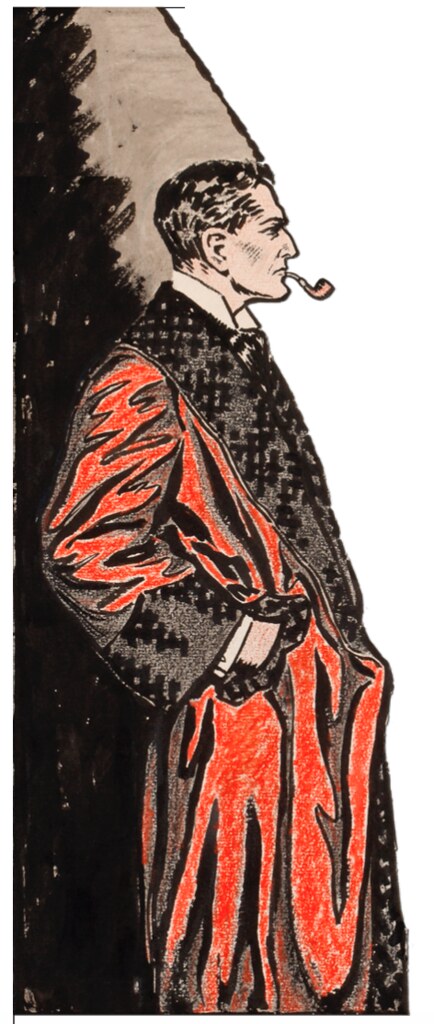
Sherlock Holmes in 221 Objects
Since his first appearance in 1887 during the 50th year of Queen Victoria’s reign, Sherlock Holmes has been nothing short of a literary juggernaut. The Great Detective who dazzled 19th-century readers is just as alive for their 21st-century counterparts, as evident in the Grolier Club’s first exhibition of 2022.
Sherlock Holmes in 221 Objects draws upon the preeminent Sherlock Holmes collection assembled by Glen S. Miranker, rich in bibliographic rarities, manuscripts, books, correspondence, and artwork, all with intriguing stories to tell beyond their significance as literary and cultural landmarks. Named for the address of the detective’s Baker Street lodgings, the exhibition presents items to captivate bibliophiles, Sherlockians, and general audiences.
Highlights include leaves from The Hound of the Baskervilles; four short story manuscripts; original artwork by the British and American illustrators who created Sherlock’s iconic look for readers; a wealth of holograph letters from Arthur Conan Doyle to friends, colleagues, and well-wishers; and a fascinating cache of pirated editions (books published without the author’s permission).
One-of-a-kind objects include the only known salesman’s dummy for the US Hound; a unique first UK edition of The Adventures of Sherlock Holmes in dust jacket; an “idea book” of Conan Doyle’s private musings in transition to the germ of stories; and a handwritten speech—never before displayed—with the author’s explanation for killing Holmes: "I have been much blamed for doing that gentleman to death but I hold that it was not murder but justifiable homicide in self defence [sic] since if I had not killed him he would certainly have killed me."
The exhibition opens not with Sherlock’s first appearance but with a story everyone knows, The Hound of the Baskervilles, presented through rarely seen and unique artifacts. It then reverts to the detective’s beginnings, focusing on Conan Doyle’s Sherlockian writings from A Study in Scarlet (1887) through the publication of The Return of Sherlock Holmes (1903).
Visitors to the exhibition will readily see evidence of Glen’s favorite collecting strategy: assembling “clumps.” “I like to assemble objects that tell a richer story as a group than they can individually,” he explains. “They offer more insight together, imparting a more complete understanding than one object can do singly.” Some examples:
- By itself, the Newnes Sixpenny edition of the Hound is a striking book, but its impact is more complete when one reads Conan Doyle’s note agreeing to its publication and also sees the original artwork for its cover. It’s a clump that provides a richer view of a moment in the life of the author and in the ongoing publication history of the Hound.
- During the three decades that William Gillette performed in the play Sherlock Holmes, his phenomenal publicity machine cranked out all manner of souvenirs, posters, and programs—all represented in Glen’s collection. But for the human side of the business of show business, Glen prizes Gillette’s correspondence with Conan Doyle, including a 1901 Christmas card with this note: “Did you ever imagine that Sherlock would be sending his compliments to his maker?”
Glen’s collection is also known for its singular objects and items with odd backstories, which he pursues relentlessly, for revelations that go beyond two-dimensional text on the page:
- As a bibliographic oddity, the copy of The Sign of the Four owned by Chicago businessman H. N. Higinbotham can’t be topped. It’s a piracy, a publishing practice that enraged many authors, Conan Doyle included. Yet Conan Doyle inscribed this book to Higinbotham, who also signed it and tucked in a ticket stub from the 1893 World’s Columbian Exposition, which he helped organize.
- For another backstory, consider the only known copy in dust jacket of the first UK edition of The Adventures of Sherlock Holmes (1892). It was uncertain whether it had been published in a dust jacket until a copy surfaced in 1981. Among its owners, in the 20 years before Glen acquired it, was a man who was not only the most notorious literary forger of the 20th century but also a murderer.
The Sherlockian Canon is small—just 56 short stories and four novels—but the opportunities and challenges for a gently mad collector are vast, often daunting, always irresistible. To Glen, the game is perennially afoot.

